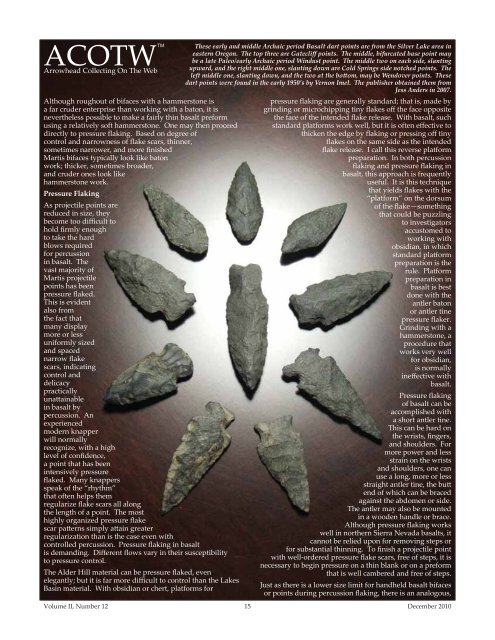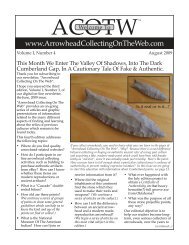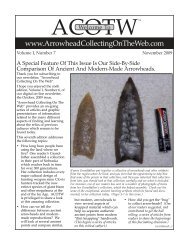Rock, Paper, Scissors - Arrowhead Collecting On The Web
Rock, Paper, Scissors - Arrowhead Collecting On The Web
Rock, Paper, Scissors - Arrowhead Collecting On The Web
Create successful ePaper yourself
Turn your PDF publications into a flip-book with our unique Google optimized e-Paper software.
ACOTW<br />
<strong>Arrowhead</strong> <strong>Collecting</strong> <strong>On</strong> <strong>The</strong> <strong>Web</strong><br />
<strong>Arrowhead</strong> <strong>Collecting</strong> <strong>On</strong> <strong>The</strong> <strong>Web</strong><br />
TM<br />
Although roughout of bifaces with a hammerstone is<br />
a far cruder enterprise than working with a baton, it is<br />
nevertheless possible to make a fairly thin basalt preform<br />
using a relatively soft hammerstone. <strong>On</strong>e may then proceed<br />
directly to pressure fl aking. Based on degree of<br />
control and narrowness of fl ake scars, thinner,<br />
sometimes narrower, and more fi nished<br />
Martis bifaces typically look like baton<br />
work; thicker, sometimes broader,<br />
and cruder ones look like<br />
hammerstone work.<br />
Pressure Flaking<br />
As projectile points are<br />
reduced in size, they<br />
become too diffi cult to<br />
hold fi rmly enough<br />
to take the hard<br />
blows required<br />
for percussion<br />
in basalt. <strong>The</strong><br />
vast majority of<br />
Martis projectile<br />
points has been<br />
pressure fl aked.<br />
This is evident<br />
also from<br />
the fact that<br />
many display<br />
more or less<br />
uniformly sized<br />
and spaced<br />
narrow fl ake<br />
scars, indicating<br />
control and<br />
delicacy<br />
practically<br />
unatt ainable<br />
in basalt by<br />
percussion. An<br />
experienced<br />
modern knapper<br />
will normally<br />
recognize, with a high<br />
level of confi dence,<br />
a point that has been<br />
intensively pressure<br />
fl aked. Many knappers<br />
speak of the “rhythm”<br />
that often helps them<br />
regularize fl ake scars all along<br />
the length of a point. <strong>The</strong> most<br />
highly organized pressure fl ake<br />
scar patt erns simply att ain greater<br />
regularization than is the case even with<br />
controlled percussion. Pressure fl aking in basalt<br />
is demanding. Diff erent fl ows vary in their susceptibility<br />
to pressure control.<br />
<strong>The</strong> Alder Hill material can be pressure fl aked, even<br />
elegantly; but it is far more diffi cult to control than the Lakes<br />
Basin material. With obsidian or chert, platforms for<br />
<strong>The</strong>se early and middle Archaic period Basalt dart points are from the Silver Lake area in<br />
eastern Oregon. <strong>The</strong> top three are Gatecliff points. <strong>The</strong> middle, bifurcated base point may<br />
be a late Paleo/early Archaic period Windust point. <strong>The</strong> middle two on each side, slanting<br />
upward, and the right middle one, slanting down are Cold Springs side notched points. <strong>The</strong><br />
left middle one, slanting down, and the two at the bott om, may be Wendover points. <strong>The</strong>se<br />
dart points were found in the early 1950’s by Vernon Imel. <strong>The</strong> publisher obtained them from<br />
Jess Anders in 2007.<br />
pressure fl aking are generally standard; that is, made by<br />
grinding or microchipping tiny fl akes off the face opposite<br />
the face of the intended fl ake release. With basalt, such<br />
standard platforms work well, but it is often eff ective to<br />
thicken the edge by fl aking or pressing off tiny<br />
fl akes on the same side as the intended<br />
fl ake release. I call this reverse platform<br />
preparation. In both percussion<br />
fl aking and pressure fl aking in<br />
basalt, this approach is frequently<br />
useful. It is this technique<br />
that yields fl akes with the<br />
“platform” on the dorsum<br />
of the fl ake—something<br />
that could be puzzling<br />
to investigators<br />
accustomed to<br />
working with<br />
obsidian, in which<br />
standard platform<br />
preparation is the<br />
rule. Platform<br />
preparation in<br />
basalt is best<br />
done with the<br />
antler baton<br />
or antler tine<br />
pressure fl aker.<br />
Grinding with a<br />
hammerstone, a<br />
procedure that<br />
works very well<br />
for obsidian,<br />
is normally<br />
ineff ective with<br />
basalt.<br />
Pressure fl aking<br />
of basalt can be<br />
accomplished with<br />
a short antler tine.<br />
This can be hard on<br />
the wrists, fi ngers,<br />
and shoulders. For<br />
more power and less<br />
strain on the wrists<br />
and shoulders, one can<br />
use a long, more or less<br />
straight antler tine, the butt<br />
end of which can be braced<br />
against the abdomen or side.<br />
<strong>The</strong> antler may also be mounted<br />
in a wooden handle or brace.<br />
Although pressure fl aking works<br />
well in northern Sierra Nevada basalts, it<br />
cannot be relied upon for removing steps or<br />
for substantial thinning. To fi nish a projectile point<br />
with well-ordered pressure fl ake scars, free of steps, it is<br />
necessary to begin pressure on a thin blank or on a preform<br />
that is well cambered and free of steps.<br />
Just as there is a lower size limit for handheld basalt bifaces<br />
or points during percussion fl aking, there is an analogous,<br />
Volume II, Number 12 15<br />
December 2010








